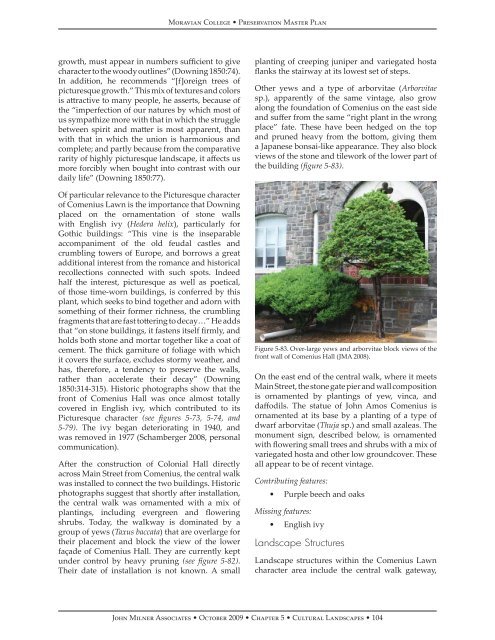Moravian Preservation Master Plan.indb - Society for College and ...
Moravian Preservation Master Plan.indb - Society for College and ...
Moravian Preservation Master Plan.indb - Society for College and ...
You also want an ePaper? Increase the reach of your titles
YUMPU automatically turns print PDFs into web optimized ePapers that Google loves.
<strong>Moravian</strong> <strong>College</strong> • <strong>Preservation</strong> <strong>Master</strong> <strong>Plan</strong><br />
growth, must appear in numbers sufficient to give<br />
character to the woody outlines” (Downing 1850:74).<br />
In addition, he recommends “[f]oreign trees of<br />
picturesque growth.” This mix of textures <strong>and</strong> colors<br />
is attractive to many people, he asserts, because of<br />
the “imperfection of our natures by which most of<br />
us sympathize more with that in which the struggle<br />
between spirit <strong>and</strong> matter is most apparent, than<br />
with that in which the union is harmonious <strong>and</strong><br />
complete; <strong>and</strong> partly because from the comparative<br />
rarity of highly picturesque l<strong>and</strong>scape, it affects us<br />
more <strong>for</strong>cibly when bought into contrast with our<br />
daily life” (Downing 1850:77).<br />
Of particular relevance to the Picturesque character<br />
of Comenius Lawn is the importance that Downing<br />
placed on the ornamentation of stone walls<br />
with English ivy (Hedera helix), particularly <strong>for</strong><br />
Gothic buildings: “This vine is the inseparable<br />
accompaniment of the old feudal castles <strong>and</strong><br />
crumbling towers of Europe, <strong>and</strong> borrows a great<br />
additional interest from the romance <strong>and</strong> historical<br />
recollections connected with such spots. Indeed<br />
half the interest, picturesque as well as poetical,<br />
of those time-worn buildings, is conferred by this<br />
plant, which seeks to bind together <strong>and</strong> adorn with<br />
something of their <strong>for</strong>mer richness, the crumbling<br />
fragments that are fast tottering to decay…” He adds<br />
that “on stone buildings, it fastens itself firmly, <strong>and</strong><br />
holds both stone <strong>and</strong> mortar together like a coat of<br />
cement. The thick garniture of foliage with which<br />
it covers the surface, excludes stormy weather, <strong>and</strong><br />
has, there<strong>for</strong>e, a tendency to preserve the walls,<br />
rather than accelerate their decay” (Downing<br />
1850:314-315). Historic photographs show that the<br />
front of Comenius Hall was once almost totally<br />
covered in English ivy, which contributed to its<br />
Picturesque character (see figures 5-73, 5-74, <strong>and</strong><br />
5-79). The ivy began deteriorating in 1940, <strong>and</strong><br />
was removed in 1977 (Schamberger 2008, personal<br />
communication).<br />
After the construction of Colonial Hall directly<br />
across Main Street from Comenius, the central walk<br />
was installed to connect the two buildings. Historic<br />
photographs suggest that shortly after installation,<br />
the central walk was ornamented with a mix of<br />
plantings, including evergreen <strong>and</strong> flowering<br />
shrubs. Today, the walkway is dominated by a<br />
group of yews (Taxus baccata) that are overlarge <strong>for</strong><br />
their placement <strong>and</strong> block the view of the lower<br />
façade of Comenius Hall. They are currently kept<br />
under control by heavy pruning (see figure 5-82).<br />
Their date of installation is not known. A small<br />
planting of creeping juniper <strong>and</strong> variegated hosta<br />
flanks the stairway at its lowest set of steps.<br />
Other yews <strong>and</strong> a type of arborvitae (Arborvitae<br />
sp.), apparently of the same vintage, also grow<br />
along the foundation of Comenius on the east side<br />
<strong>and</strong> suffer from the same “right plant in the wrong<br />
place” fate. These have been hedged on the top<br />
<strong>and</strong> pruned heavy from the bottom, giving them<br />
a Japanese bonsai-like appearance. They also block<br />
views of the stone <strong>and</strong> tilework of the lower part of<br />
the building (figure 5-83).<br />
Figure 5-83. Over-large yews <strong>and</strong> arborvitae block views of the<br />
front wall of Comenius Hall (JMA 2008).<br />
On the east end of the central walk, where it meets<br />
Main Street, the stone gate pier <strong>and</strong> wall composition<br />
is ornamented by plantings of yew, vinca, <strong>and</strong><br />
daffodils. The statue of John Amos Comenius is<br />
ornamented at its base by a planting of a type of<br />
dwarf arborvitae (Thuja sp.) <strong>and</strong> small azaleas. The<br />
monument sign, described below, is ornamented<br />
with flowering small trees <strong>and</strong> shrubs with a mix of<br />
variegated hosta <strong>and</strong> other low groundcover. These<br />
all appear to be of recent vintage.<br />
Contributing features:<br />
• Purple beech <strong>and</strong> oaks<br />
Missing features:<br />
• English ivy<br />
L<strong>and</strong>scape Structures<br />
L<strong>and</strong>scape structures within the Comenius Lawn<br />
character area include the central walk gateway,<br />
John Milner Associates • October 2009 • Chapter 5 • Cultural L<strong>and</strong>scapes • 104

















